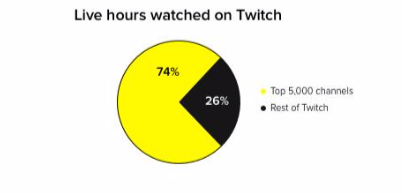Twitch Still Live-Streaming Champ Despite Growing Competition: Study
Despite YouTube's 2 billion users and 500 hours of (recorded) video uploaded per minute, Twitch remains the heavyweight champ of livestreaming in the gaming and esports world, according to a new study from StreamElement.
In fact, the Amazon-owned Twitch has about four times the number of hours watched per month compared to YouTube Live, according to stats from StreamElements. That translates to nearly three-fourths of all live streaming view time in the second quarter, or about 2.72 billion hours.
By comparison, YouTube Live grabbed slightly less than 20 percent of the 3.77 billion hours watched live. Facebook Gaming (5.3 percents) and Microsoft-owned Mixer (3 percent) grabbed the balance.
The numbers make clear one thing: live-streaming influencers are becoming a thing. And the biggest new thing is Tfue, who had more than 5 million hours watched in the second quarter of the year.
That outstripped even Ninja, who has been the most prominent streamer to break through to the broader culture, helped by such tactics as playing with famous musicians and athletes, and spinning out music and book deals attached to his brand.
Though no streamer was consistently at the top of the Twitch viewership rankings in the first half of 2019, StreamElements tabbed Tfue, Ninja and Shroud as frequent leaders, with LIRIK, xQcOW and Asmongold among the new names in the top 5 at some point so far.
For influencers on Twitch, it helps to be big, StreamElements found. Where the big trend in influencer marketing has been so-called micro- and even nano influencers, the StreamElements study focused on Twitch's top 5,000 livecasters. Together, those 5,000 attracted 2 billion of the almost 2.7 billion hours of viewing on Twitch.

The advantage in attention for the top streamers is only accelerating, as they build larger and larger concurrent audiences. The top 200 channels have about 10,600 people watching together on average.
I moderated a fireside chat this week at the Influencer Marketing Convention & Expo with Kym Nelson, the SVP of ad sales for Twitch.
There, she made it clear how the channel is pushing beyond its gaming roots, running marathons of non-gamer shows such as Bob Ross' old public-TV painting show, spotlighting and otherwise supporting non-gamer streamers, and reaching out to non-endemic advertisers trying to reach the young, male audience that predominates on Twitch.
The StreamElements study found that viewership of top gaming titles such as Fortnite, League of Legends, and Counter-Strike: Global Offensive actually declined, while the site's "Just Chatting" component grew 7.7 percent. "Just Chatting" is the closest analog to much of YouTube's most popular group of influencers, the personality-driven life vloggers.

And though watching esports remains hugely popular on Twitch, its less frequent appearance there means esports (and brand-driven) streams make up less than a quarter of the total hours watched on Twitch compared to the streamers.
The study suggested that brands that want to get into livestreaming should be "expanding their focus beyond esports to the much broader selection of influencers who are driving the hours watched on Twitch."
A separate, broader study on digital video consumption – released Thursday by Vorhaus Advisors and the Manatt, Phelps & Phillips law firm – found that more than half of users 18 years or older watch live-streaming video every week. Among those 18 to 34 years old, the number jumps to more than two-thirds, And a third of the younger viewers watch live-streaming video every day.
Among the content areas most likely to be viewed, according to the Manatt-Vorhaus study: breaking news, comedy and live sports, all watched by at least 35 percent of those surveyed.
A key part of live streaming's appeal: it makes viewers feel "updated and informed." A third of those surveyed also said live-streaming "feels authentic."
In this study of 2,007 U.S. adults, viewers watched more live content of all kinds on Facebook Live (39 percent), YouTube Live, Instagram (both 37 percent) and Twitter (22 percent) than they did on Twitch (21 percent).

